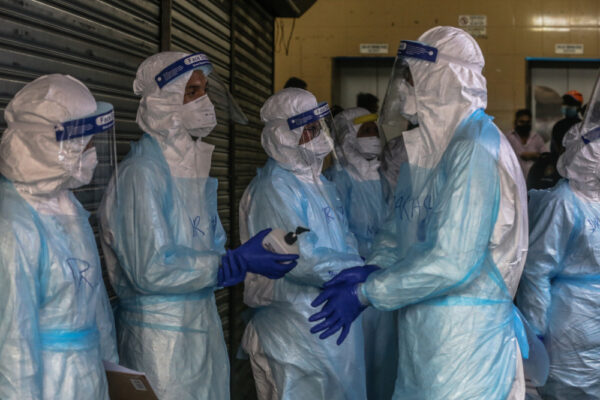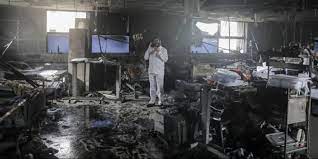A new discovery on mammals and their potential ability to “breathe” through their rectum in the intestines paved the way for a new potential way to treat humans with severe respiratory problems. The research comes from the Tokyo Medical and Dental University and Cincinnati Medical Center, revealing that pigs and rodents are both capable of “intestinal breathing”.
The discovery seems absurd, but it is not unprecedented. Some aquatic organisms, including catfish and sea cucumbers, can use their intestines to breathe in situations that call it. This new study discovered that pigs, rats and mice can use intestinal respiration with increased survival probability in an extremely low oxygen environment.
The study involved the development of a ventilation system of intestinal gas, used to pump pure oxygen through the rectum and in the intestines of mice. These mice were placed in an extremely low oxygen environment – the type that would cause death without additional oxygen – and 75% of them survived for 50 minutes with the intestinal breathing apparatus.
However, there was a disadvantage of this system, however that the gas ventilation apparatus caused an “abrasion of the intestinal mucosa”, which means that it would not be a reasonable option to use with patients with affected patients of illness. To solve this problem, the researchers proposed a different option: oxygenated perfluorochemicals in a liquid.
Oxygenated liquid has been found that pigs and rodents in low oxygen environments, with more oxygen reaching their hearts. Similarly, their oxygen levels have increased, reduced coldness and mice have been able to walk further in the low oxygen chamber. The results have suggested potential future applications for humans.
The main author of the Takanori Takebe study explained:
The recent SARS-COV-2 pandemic is overwhelming the clinical need for artificial fans and lungs, resulting in a critical scarcity of available devices and endangers patients’ lives around the world. The level of arterial oxygenation provided by our ventilation system, if it is probably sufficient to treat patients with severe respiratory failure, potentially offering life backup oxygenation.

![How to Solve [pii_email_e188285bdb71eb7570eb] error](https://tomtomworks.com/wp-content/uploads/2021/09/How-to-Solve-pii_email_e188285bdb71eb7570eb-error-520x293.jpg)










![Have you been encountering the [pii_email_2c5d108980d117c8ca52] error while trying to send or receive emails using your Outlook account, you’re not alone. It’s a standard Outlook error that sometimes gets triggered thanks to network connectivity issues. However, several other factors also can cause you to run into the said error. The good news is that you simply can troubleshoot this error by yourself. during this guide, we are getting to mention various factors that cause the PII error and what methods you'll utilize to repair it. So, with none further ado, let’s start . What Causes the [pii_email_2c5d108980d117c8ca52] Error in MS Outlook In general, the error occurs when MS Outlook fails to determine a secure reference to the e-mail server. But, as we mentioned earlier, there are many other reasons which will trigger this error also . a number of these reasons include: Your device isn't connected to a lively Internet connection Your Outlook profile has been damaged thanks to external factors There are incorrect antivirus configurations on your PC FIles on your POP3 server are damaged How to Fix [pii_email_2c5d108980d117c8ca52] Error So, now that you simply know what triggers the [pii_email_2c5d108980d117c8ca52] error in Outlook, let’s take a glance at the solutions that’ll assist you fix it. Also examine the way to fix outlook [pii_email_316cb5e2e59f1ce78052] error Check Your Internet Connection Since a poor network connection is that the primary explanation for the error, start by checking your Internet connection. confirm that your device has active Internet connectivity. you'll try accessing other online services to ascertain if the web is functioning or not. Change Antivirus Configurations If you've got recently installed an Antivirus program on your PC, it'd be configured to automatically scan emails. If that’s the case, the Antivirus will restrict the Outlook app from functioning properly. So, confirm to vary the Antivirus Configurations by disabling the “Email Scanning” feature. Reinstall/Update Outlook Reinstalling or updating Outlook to the newest version is yet one more effective thanks to fix the [pii_email_2c5d108980d117c8ca52] error. When you’ll reinstall the app, all the damaged temporary files are going to be deleted and therefore the root of the matter are going to be eliminated also . Clear Unnecessary Emails from Outlook Folder If your primary inbox has too many unnecessary emails, they’ll cause bandwidth issues. this is often the rationale it’s always advised to clear the unnecessary emails from your Outlook folders. While you’re at it, confirm to clear the Trash also . this may help your Outlook app to deliver optimal performance. Conclusion So, if you’ve been encountering the [pii_email_2c5d108980d117c8ca52] error for a short time now, the above-mentioned will assist you fix the matter . Follow these tricks and access your Outlook account with none hassle.](https://tomtomworks.com/wp-content/uploads/2021/09/How-to-fix-outlook-pii_email_2c5d108980d117c8ca52-er-200x200.webp)

![How To Fix [pii_email_71e6bcfa8a2bee2aa151] Erro](https://tomtomworks.com/wp-content/uploads/2021/09/How-To-Fix-pii_email_71e6bcfa8a2bee2aa151-Erro-200x200.jpg)




